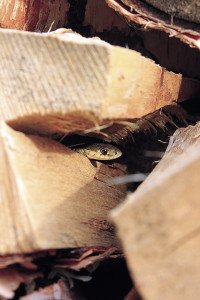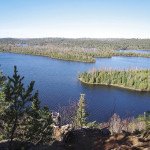Gunflint Trail—What’s in your woodpile? If we asked ourselves that question, we might answer “wood,” but that answer is not entirely correct.
Most “northerners” stack birch, maple, aspen and sometimes ash for indoor woodstoves and fireplaces. Outdoor fire piles may include balsam fir, Norway pine or tamarack.
How is it stacked? That is the next common question among outdoor enthusiasts and folks who love a good campfire.
Most people stack their wood in the traditional row woodpile. Others just create a huge pile of wood and hope it will all dry. Some like to make a birch silo with the center hollow to create a chimney effect to help dry the wood. Once it is good and dry, it goes into individual firewood bins, ready to be used for campfires and woodstoves.
Another way to stack wood is the artistic approach. A quick check on the internet will show multiple pictures of people who have a lot of time to create impressive sculptures out of the split wood, by stacking it in just the right order.
If you want to see a woodsman cringe, ask if it is better to stack wood with the bark facing up or down. I prefer to stack it bark up and bark down, so the pile is more condensed and stronger.
Most rural fire fighters will instruct you not to pile wood against your house. It invites insects inside your walls and is a fire hazard. If there is a woodland wild fire and the fire sends sparks into the woodpile, chances are they cannot save your home.
Let’s discuss the usual way most of us stack firewood; the “high rise.” In my family, we start with a base of wood pallets. They are cheap, usually free, and a great way to get your fire wood off the ground. Plus, they can be leveled so you can stack on an even area. Other folks use long logs or boards on the ground and stack crosswise to the length of the log.
The corners of woodpiles can be a challenge best met by towers of half logs carefully piled with each layer 90 degrees off of the previous layer. This creates a strong corner. If you are careful, you can intentionally lean the corner towards the center of the pile for even greater support. It is nice to let gravity work for you. A driven metal post works too, but doesn’t look as aesthetically pleasing.
Growing up on the Gunflint Trail, we used 16 or more cords a year, so the woodpile was pretty big. To keep it from falling, we crafted careful corners in a crisscross pattern and every couple layers of wood we would put a long piece between two rows to tie them together. It also served as a good way to hide the pieces you cut too long. These “stabilizers” did a great job keeping the woodpile upright.
Split pieces of wood are placed split side down on the edge for starters. This keeps your firewood from rolling out of the pile. The next level is bark down, then bark up, etc. until you need one of the horizontal stabilizers. Keep adding pieces, leaving at least 6 inches of open space between rows lengthwise.
So what’s in your woodpile? The answer is as simple as starting at the bottom and working your way up.

The base wood resting on the pallets is a few inches off the ground and creates a perfect highway for small critters, insects and more. Mice like seeds and occasional insects for an easy snack. Shrews dine on beetles and worms. Weasels will wind in and out of the pile looking for their meal, too. The beetles are happy to dine on slugs and other things that thrive in the loose, moist soil, along with centipedes, millipedes and plenty of other bugs. Salamanders will take up the space under the basement layer.
Spiders, which are not bugs but arachnids, will crawl up and down the woodpile hunting in and out of the cavities and hollows created from wood. Ants will create colonies under the base wood or under the bark of a piece of wood. Larger ants, such as the black ants, or the huge carpenter ants, create pathways and trails as they chomp their way through the wood.
These larger ants and bugs are a constant menu item for garter snakes, searching the woodpile for an easy meal. Snakes will use also the rough edge of the logs to shed their skin as they grow. Snakes love to sun themselves partially out of the woodpile, but not completely exposed or a hungry hawk might spot them.
Inside the wood and often crawling around under the bark, is the larva of some beetles, eating and crawling through the wood. Paper wasps and other bees will make their nests in the woodpile, especially along the edges. This can lead to some painful surprises if you do not find them first. The paper from the nest is a great way to start your outdoor fires with a flint and steel.
Occasionally, Bats hang out in the upper spots usually facing south or east. Bats like their privacy and tend to seek a new place to hang out if they are disturbed.
At our home, we have observed North American fly catchers, sitting atop the pile, watching for flies and beetles. A quick trip and the bird has lunch on the fly.
That leads to the question, can you encourage the birds to nest in your woodpile? The answer is yes. If you have an overhanging tarp covering the wood, you can create a nesting platform facing west, north or east. Birds will use this exposed but covered area as a nesting site. Be sure to have plenty of horizontal space for the birds to put a nest. I’ve had robins build a nest in the clothes pin bag, so anything is possible with birds.
Your woodpile is quite cool in the center. You can use that cool center to keep fish bait, such as night crawlers, out of the sun. Keep them in a tight container and place it deep in the center of the pile. Tie a piece of rope on it so you can retrieve your bait when you want to go fishing.
Winter is approaching, which means it’s time to stack and prepare our wood piles for the host of critters that move in. Just remember to bang the pieces together firsts before you bring the wood inside.—Patrick Baumann





